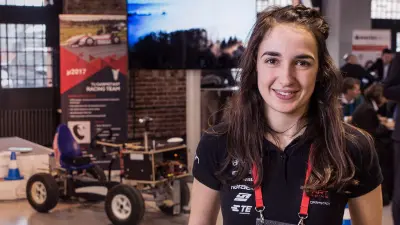Pole position for autonomous racing cars
In dialogue with the computer scientist and developer of driverless racing vehicles

2018-08-21
Her words throw down the gauntlet to Formula 1 pilots like Sebastian Vettel and Lewis Hamilton: “In a few years,” says Annemike Unterschütz, “driverless racing cars will be quicker than ones with people behind the steering wheel.”
Flying start with Formula Student Driverless
For Unterschütz, it is more than a daring theory. It is her declared goal. The 22 year old is a member of the TU Darmstadt Racing Team, in short DART Racing. Together with her teammates she is working on a fully self-driving racing car.
DART Racing will take the car to the Formula Student grid, the world’s biggest construction competition for universities. The contest for budding engineers was inaugurated in 1981 by the Society of Automotive Engineers (SAE) in the USA. In 2017, Formula Student officials proved they had a feel for the zeitgeist by adding the Driverless Class to the competition, thus making it clear just how important autonomous driving is for automotive and IT manufacturers. Unterschütz welcomed the decision saying, “Driverless racing cars are a very nice example of what is possible.”
“I guess in a few years, driverless racing cars will be faster, especially in races like acceleration.”
High speed development

The conditions on the race track obviously differ significantly to those daily on the roads. “We don’t have to worry about pedestrians, we don’t have other cars,” says Unterschütz. She nevertheless sees a big advantage in being able to blend out such factors. “By working in what is basically a protected space, we can illuminate specific problems involved in autonomous driving and search for solutions. It includes for example recognition of the road ahead and any obstacles. It’s easier to test in an area with no public access than on the roads.”
9 months
The duration of the development phase of a driverless racing car.
The motor racing circuit as the test track for self-driving cars: What it is actually like in practice is shown for example by the Formula Student Driverless’ acceleration competition. The racing cars are accelerated from a standing start – TU Darmstadt’s basic vehicle reaches 100 kilometers per hour in less than three seconds. In contrast to a human driver, the machine cannot make a mistake: “The optimal acceleration process can be programmed,” says Unterschütz.
Sensors instead of pilots
Does the experience of racing drivers nevertheless flow into the development of driverless racing cars? “No”, says Unterschütz, “the ideal line around the circuit can be calculated by means of a simulation. The right touch behind the steering wheel is therefore superfluous: “Sensors and cameras are all that’s needed for a driverless racing car.”
An interview with Annemike Unterschütz, computer scientist

Loading the video requires your consent. If you agree by clicking on the Play icon, the video will load and data will be transmitted to Google as well as information will be accessed and stored by Google on your device. Google may be able to link these data or information with existing data.

Annemike Unterschütz, 22
Computer scientist and developer of driverless racing vehicles
The car itself knows the best way to accelerate.
After passing her school leaving examination in 2013, Annemike Unterschütz studied Chinese and literature in the Guilin region in China. In 2018, she graduated in computer science from the TU Darmstadt where she is a member of the ten-person Formula Student Driverless core team.
Summary
Motor racing competitions with driverless cars are more than just a spot of fun: Valuable information for further developments in autonomous driving can be won here — at high speed.


